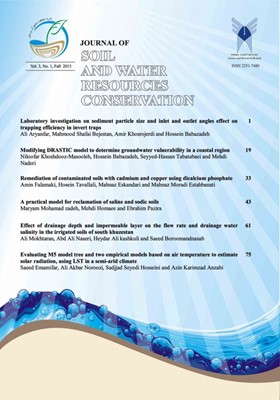Laboratory investigation on sediment particle size and inlet and outlet angles effect on trapping efficiency in invert traps
Subject Areas : Farm water management with the aim of improving irrigation management indicators
Ali Aryanfar
1
,
Mahmood Shafai Bejestan
2
,
Amir Khosrojerdi
3
![]() ,
Hossein Babazadeh
4
,
Hossein Babazadeh
4
![]()
1 - Ph.D. student, Department of Water Engineering, College of Agriculture and Natural Resources, Tehran Science and Research Branch, Islamic Azad University, Tehran, Iran
2 - Professor, Department of Hydraulic Structures, Faculty of Water Sciences Engineering, Shahid Chamran University of Ahvaz, Ahvaz, Iran
3 - Assistant Professor, Department of Water Engineering, College of Agriculture and Natural Resources, Tehran Science and Research Branch, Islamic Azad University, Tehran, Iran
4 - Assistant Professor, Department of Water Engineering, College of Agriculture and Natural Resources, Tehran Science and Research Branch, Islamic Azad University, Tehran, Iran
Keywords: physical model, sediment traps basins, trap efficiency,
Abstract :
Invert traps are one of the most effective methods for separating and collecting sediments in open channels. In this research, some experiments were performed in a channel with 4 m long and 25 cm wide for 13 different invert trap configurations with different inlet and outlet angles. To determine the best trap geometry that has the most retention ratios, four types of plastic beads as a laboratory sediments with the same density but different size and apparent weight were tested in a constant time. Results showed that the inlet and outlet angles of the trap, has a considerable impact on the amount of deposited sediments. In the case of vertical walls of the entrance, whatever outlet wall of the trap has milder angle, trapping rate was larger the incoming angle of the trap was smooth and the outlet wall is vertical, although sediments could easily sinked in, but due to strong vortices formed downstream of the trap, much of these sediments re-suspended and directed away from the trap. Quantitative analysis of the results showed that from the 13 tested geometries, trap with inlet angle of 90° and 34° as an outlet angle, has the highest efficiency on trapping the sediments.


